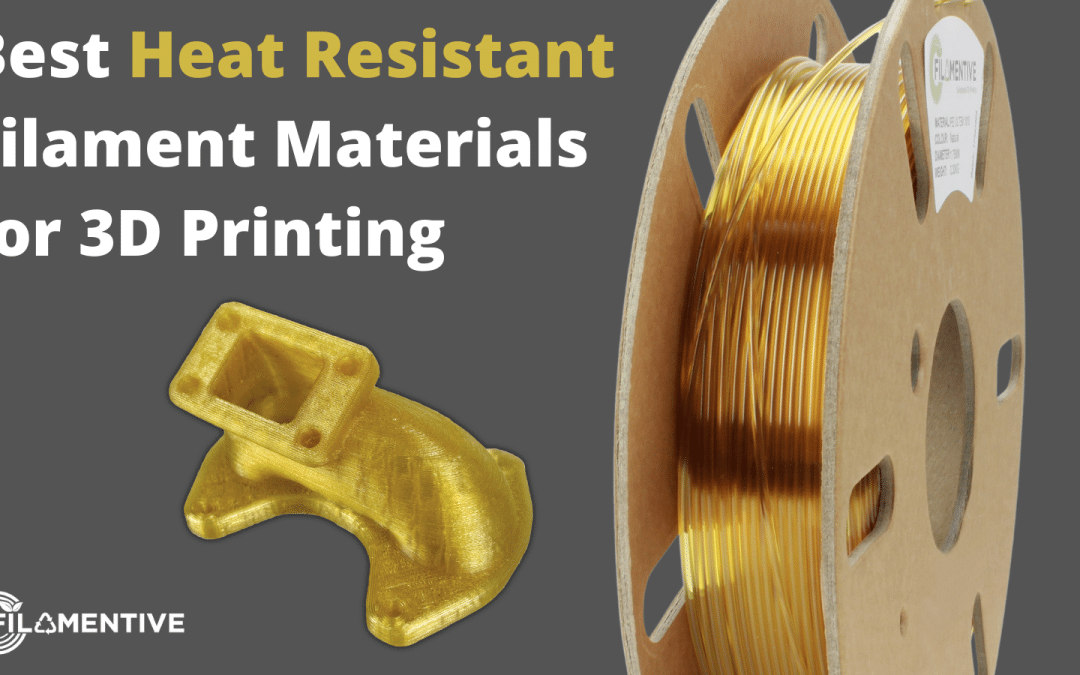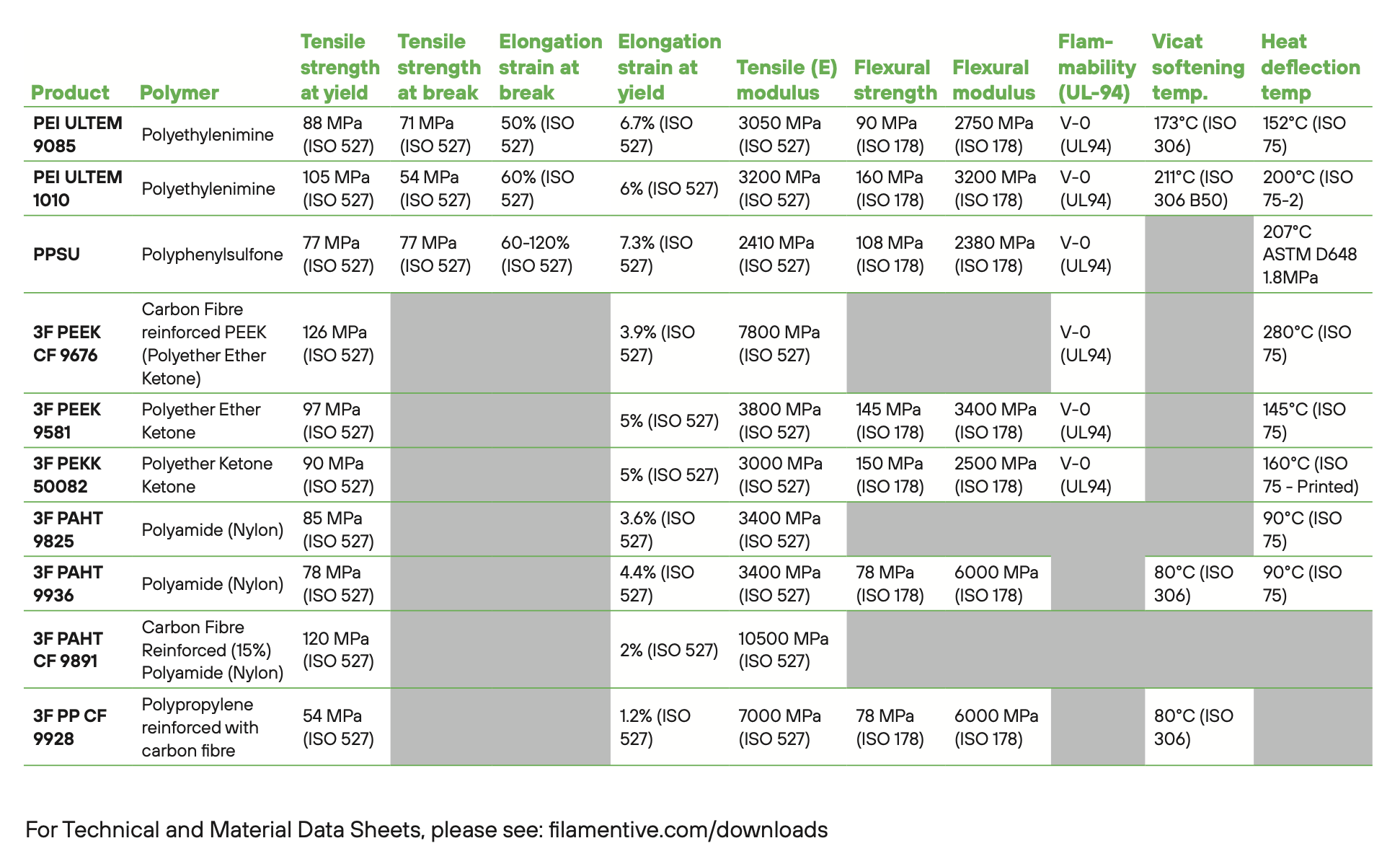With 3D printing increasingly used in industry for the production of end-use parts, “which filaments are heat resistant?” is a frequently asked question at Filamentive HQ.
This article therefore seeks to answer those very questions – specifically, defining what heat resistance means, outlining the heat resistance properties of our filament materials, as well as offering advice to aid the decision-making process when choosing heat resistance filament for your next 3D printing project.
What is Heat Resistance?
HDT – Heat Deflection Temperature
HDT is a measure of resistance to distortion under a given load at elevated temperature. In practical terms, HDT is a measure of the stiffness as the temperature increases.
The inherent properties of the polymer are not the only contributing factors to HDT. Any ingredient in the formulation – including additives that increase 3D printing performance – can impact HDT, e.g.,, if it makes a material more stiff, it will also increase HDT.
Vicat Softening Temperature
The Vicat softening temperature is the temperature at which a flat-ended needle penetrates the specimen to the depth of 1 mm under a specific load. This is a specific test (ASTM D1525, ISO 306) which identifies the point of softening that can be expected when a material is used at elevated temperature.
When compared to HDT, the Vicat number is usually higher as this is the point that is closer to the actual polymer melting point. In short, Vicat identifies the temperature at which stability form is lost, and HDT identifies the point at which load-bearing is lost.
Tg – Transition Glass Temperature
Tg is a different property. Specifically, the Tg is the temperature at which a crystalline or semi-crystalline material melts – thus becoming amorphous.
In the real world, a good example is ice changing from it’s crystalline (solid) structure, into a liquid (water) – it’s amorphous structure. In such an instance, the Tg of water is 0°C.
However, it’s important to note that polymer structures are much more complex than water. Due to this, it is possible that a material can have more than one Tg. In contrast to the HDT of a polymer, the Tg is minimally impacted (if at all) by additives.
HDT, Vicat and Tg are NOT interchangeable – these properties measure different features of a polymer and so it is not advised to compare the HDT of one material to the Tg of another.
Typically, the property that is important is the HDT as it adequately indicates mechanical performance at elevated temperatures. Tg alone does not do this.
Comparing the Heat Resistance of 3D Printing Materials
The table below outlines the Technical Data of Filamentive Materials, including Thermal Properties such as Vicat, HDT and Tg.
The table below outlines the Technical Data of Filamentive PRO Materials, including Thermal Properties such as Vicat, HDT and Tg.
Choosing the Best Filament for Heat Resistance
If you require very high heat resistance for industrial / end-use applications, Filamentive PRO high temperature polymers such as PEEK, PEKK, PEEK-CF and Ultem are recommended. As explained in our Comparing High Performance 3D Printing Filament article, PEEK Carbon Fibre (PEEK-CF) has the highest HDT, at 280°C. If continuous use is more crucial than the actual highest temperature, it’s important to note that Ultem offers continuous use up to 170 ºC – outperforming PEEK. Whilst advantageous in industry, high performance polymers may not be suited to every application – both economically and technically.
When assessing conventional filament for 3D printing, ABS and ASA have high Vicat softening temperatures – rated as 97ºC and 98ºC respectively.
For those interested in heat resistant PLA filament, Filamentive Engineering PLA – ePLA – exhibits a HDT of >95 ºC, post-annealing. If interested in comparing the different PLA filaments for 3D printing, please see our article: What is the Best PLA Filament?
Naturally, some users need a filament more heat resistant than PLA, but do not wish to print with ABS / ASA. In these instances, PETg filament offers a HDT of 70ºC and Tg of 77ºC.
Should you application require heat resistance above the limit of PETg, Carbon Fibre PETg Filament exhibits a HDT of 80ºC – as explained earlier in the article, additives can increase HDT, and a good example of this is in practice is the addition of carbon fibre which increases stiffness, and thus offers a higher HDT 10ºC higher versus regular PETg.
As always, the best filament for heat resistance is dependent on various factors. To help decide which 3D printing material is best for you, consider the following questions?
- Is this a prototype or end use part?
- Will this 3D print be subjected to temperatures >55-60ºC (i.e., beyond PLA)?
- Is heat resistance above >100ºC required? If so, can my printer print these materials?
- Is polymer stiffness (load-bearing) more critical than the softening point?
Should you wish to experiment with different materials, please note Filamentive offers 3D printer filament samples of all materials sold, as well as Tester Packs containing 50g samples of all materials currently offered.





I am wanting to print corners for my freeze dryer.
What filament do you recommend?
For printing corners for a freeze dryer, selecting a filament that ensures thermal stability, durability, and chemical resistance is important due to potential exposure to various substances. Filamentive provides a variety of filaments suitable for diverse applications, focusing on your needs, here are my recommendations:
PETG Filament: PETG is a solid choice for parts needing durability and thermal stability. It’s less brittle than PLA and offers higher temperature resistance, which could be advantageous depending on your freeze dryer’s operational conditions. PETG also stands out for its ease of printing, representing a balanced option between performance and user-friendliness.
ASA Filament: For superior temperature resistance and enhanced environmental stability (including UV resistance), ASA might be the better fit. It’s celebrated for its durability and strength, as well as resistance to weathering, making it suitable for scenarios that may encounter varied environmental conditions.
When selecting a filament, it’s also crucial to consider the specific conditions your corners will face, such as maximum temperatures and any potential chemical exposures. Additionally, ensure your 3D printer can accommodate the requirements for printing with these materials, as they may necessitate higher bed and extruder temperatures.
It’s essential to review the freeze dryer manufacturer’s guidance and liaise directly with them for material compatibility, as specific recommendations cannot be provided, and we cannot be liable for any issues that may arise. This step will help ensure that the material you choose does not negatively affect the freeze dryer’s performance or safety.